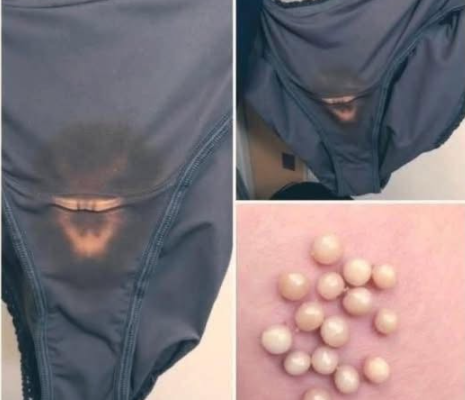⚠️ Be Careful: What Changes in Your Underwear Could Be Telling You About Your Health 🩲🚨
Most people toss their underwear into the laundry basket without giving it a second thought. But believe it or not, what shows up in your underwear can reveal important clues about your health — especially when it comes to infections, hormonal changes, or underlying medical conditions.
While not every stain or change is a cause for alarm, there are certain signs you should never ignore. Paying attention to these early warnings can help prevent bigger problems down the road. Here’s a closer look at what your underwear may be trying to tell you — and when it’s time to see a doctor.
🩺 1. Unusual Discharge or Wet Spots
Some moisture in your underwear is normal — especially for people who menstruate or experience natural bodily secretions. But if you notice sudden changes in the color, texture, or smell of discharge, it could be a warning sign.
-
Clear or white, odorless: Usually normal — your body naturally cleans itself.
-
Thick, white, and clumpy: This can be a sign of candidiasis (yeast infection).
-
Yellow or green discharge with odor: This can indicate trichomoniasis or another infection.
-
Grayish discharge with a fishy smell: This is a common sign of bacterial vaginosis.
-
Brownish discharge between periods: Sometimes normal (especially right after menstruation), but persistent brown spotting can signal a hormonal imbalance or infection.
⚠️ When to worry: If discharge comes with itching, burning, pain, or a strong smell, you should see a healthcare professional promptly.
🩸 2. Unexpected Blood or Spotting
Blood in your underwear outside of your regular menstrual cycle should never be ignored. While it can sometimes be harmless — such as light spotting from stress or hormonal changes — it can also point to more serious conditions.
Possible causes include:
-
Hormonal fluctuations (common during ovulation or birth control changes).
-
endometriosis or uterine fibroid.
-
Early signs of cervical cancer or endometrial cancer.
-
Infections or inflammation of the reproductive tract.
Spotting after sexual activity may also be linked to cervical irritation or infection.
⚠️ When to worry: Heavy, unexpected bleeding, bleeding after sex, or bleeding post-menopause always requires medical attention.
🌡️ 3. Yellow or Rust-Colored Stains
If you notice yellowish or rust-colored stains that don’t come out easily in the wash, this may be a sign of older, oxidized discharge or blood.
-
Light yellow stains can be normal in some cases — dried cervical mucus can change color over time.
-
Rust-colored or brown stains often indicate dried blood from spotting, implantation bleeding, or the end of a menstrual period.
-
Persistent yellow stains with odor, however, can be a sign of an infection that’s been going unnoticed.
⚠️ When to worry: If these stains are frequent, have an unpleasant smell, or come with other symptoms (itching, burning, pelvic pain), don’t ignore them.
🦠 4. Itchy Residue or White Patches
If you notice dried white or chalky patches in your underwear — especially paired with itching or irritation — this can signal a yeast overgrowth.
-
A thick, cottage cheese-like discharge that dries into a white crust is one of the most common symptoms of candidiasis.
-
Itching that worsens after sweating or wearing tight clothing is another classic sign.
⚠️ When to worry: Yeast infections are treatable, but if symptoms are severe or frequent, you should see a doctor. Recurrent infections can point to other health issues like diabetes mellitus or immune system imbalances.
👃 5. Strong or Unusual Odor
It’s completely normal to have a mild, natural scent in your underwear. But a strong, fishy, metallic, or foul odor should not be ignored.
Common causes include:
-
bacterial vaginosis (BV) — often described as a “fishy” smell.
-
Infections or trapped foreign objects (like forgotten tampons).
-
Hormonal changes that alter vaginal pH.
-
Sweat and bacteria buildup from tight or synthetic underwear.
⚠️ When to worry: A strong odor that persists after showering, or is paired with discharge or itching, requires medical attention.
🧼 6. Irritation Marks or Skin Discoloration
Sometimes the warning sign isn’t from discharge but from your skin. If your underwear leaves behind red, irritated patches or darker skin around the groin, it may be a sign of:
-
Skin chafing from tight clothing.
-
Allergic reactions to fabric or detergent.
-
Fungal infections like tinea cruris (jock itch).
-
Hormonal skin changes.
⚠️ When to worry: If the skin becomes itchy, flaky, cracked, or develops sores, seek medical advice to rule out infections.
🩲 7. Unexplained Dampness
Occasional dampness is common due to sweat or natural secretions. But persistent wet spots that aren’t related to discharge may be a sign of:
-
urinary incontinence (bladder leakage).
-
Excessive sweating (hyperhidrosis).
-
An undiagnosed infection or irritation.
This can be embarrassing but is more common than most people realize — and it can be treated.
⚠️ When to worry: If you often notice dampness paired with a urine-like smell, consult a healthcare provider.
🧪 8. White Powdery Residue After Washing
Not all stains mean a health problem — sometimes, the culprit is detergent buildup or hard water. However, if these white patches appear before washing, and especially if they’re accompanied by discharge or itching, it may be a yeast or bacterial imbalance.
Tip: Always use gentle, fragrance-free detergent for your underwear to avoid irritation.
🩻 9. Warning Signs That Need Immediate Attention
While many underwear changes are harmless or easily treatable, some should never be ignored:
-
Bright red bleeding outside your period
-
Foul-smelling, unusual discharge
-
Pain or burning during urination
-
Persistent itching or irritation
-
Unexplained weight loss, fatigue, or pelvic pain
These symptoms may be linked to serious infections or other conditions that need medical care.
🧼 10. How to Keep Things Healthy Down There
Prevention matters. A few daily habits can help keep your intimate area healthy and reduce the chances of irritation or infection:
-
Wear breathable cotton underwear to allow airflow.
-
Change underwear daily (or more often if sweaty).
-
Avoid tight clothing that traps moisture.
-
Use mild, fragrance-free soap or just water for cleaning.
-
Wash underwear in hot water when possible to kill bacteria.
-
Avoid scented sprays, powders, or douches.
These small steps can make a big difference in preventing irritation and infection.
🧠 Why Paying Attention Matters
Many people feel embarrassed talking about underwear stains, discharge, or odor. But your underwear is often the first place your body sends warning signs. Spotting these early can lead to quick, simple treatments rather than more complicated health issues later.
Ignoring warning signs may allow infections to spread or mask more serious problems. Listening to your body — and yes, checking your underwear — can literally save your health.
🩺 When in Doubt, Get Checked Out
If something doesn’t feel right, don’t self-diagnose or rely on internet myths. Visit a qualified healthcare professional. A simple check-up can provide peace of mind and prevent complications.
Remember:
-
Your body communicates with you in quiet ways.
-
Your underwear can be a messenger.
-
Paying attention is an act of self-care.
👉 Final Thought:
Don’t be embarrassed to look closely at your underwear. Those little signs — a stain, a smell, a patch, a spot — can carry big messages. Catching changes early can mean faster treatment, less discomfort, and better overall health.
🚨 Be careful. Listen to what your body is telling you. It might just save you from something serious. 🚨


